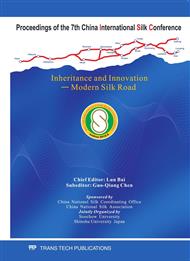p.176
p.181
p.186
p.192
p.197
p.202
p.209
p.214
p.220
Preparation and Characterization of Electrospun Silk Fibroin-Based Tubular Scaffolds
Abstract:
Artificial nerve conduits (NC) can be used as an alternative to autologous nerve grafts to enhance the repair of small nerve gaps. Many natural and synthetic biomaterials have been processed to be tubular scaffolds. However, current NC lack adequate molecular and structural functionalities. Thus, we prepared silk fibroin (SF)-based nanofibrous tubular scaffolds (inner diameter=1.5 mm) for nerve repair. The Bombyx mori silk fibroin was firstly dissolved in hexafluoroisopropanol (HFIP), and then was electrospun to be nanofibrous silk fibroin tube which topographically functionalized with aligned and non-aligned SF nanofibers. Effects of electrospinning parameters (including collection distance, rotational speed and translational speed) on the micro-morphology of SF tube were investigated. The nanofibers orientation in SF tube affects the mechanical property of SF tube. The results suggest that this tubular scaffold shows promising application in nerve tissue engineering.
Info:
Periodical:
Pages:
197-201
Citation:
Online since:
January 2011
Authors:
Keywords:
Price:
Сopyright:
© 2011 Trans Tech Publications Ltd. All Rights Reserved
Share:
Citation:


